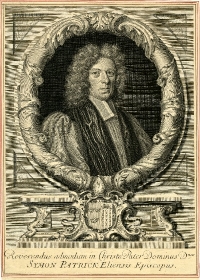Symon Patrick (1626–1707)
"Simon Patrick was an English theologian and bishop. He was born at Gainsborough, Lincolnshire, on 8 September 1626. He entered Queens College, Cambridge, in 1644, and after taking orders in 1651 became successively chaplain to Sir Walter St. John and vicar of Battersea, Surrey. He was afterwards (1662) preferred to the rectory of St. Paul's, Covent Garden, London, where he continued to labor during the plague. He was appointed dean of Peterborough in 1679, and Bishop of Chichester in 1689, in which year he was employed, along with others of the new bishops, to settle the affairs of the Church in Ireland. In 1691 he was translated to the see of Ely, which he held until his death on the 31st of May 1707
His sermons and devotional writings are numerous, and his Commentary on the Historical and Poetical Books of the Old Testament, in 10 vols., going as far as the Song of Solomon."
*******
The
Parable
Of The
Pilgrim:
Written to a Friend.
by
Symon Patrick D. D.
Chaplain in Ordinary to His Majesty.
The Fifth Edition
London,
Printed by Robert White for Francis Tyton, at the Sign of the three Daggers in Fleet-street. 1678
********
This being a most interesting book, perhaps particularly so for those who know John Bunyan's 'The Pilgrim's progress' (1678). There has been much thought and discussions as two whether either copied from the other.
Although 'The Parable of the Pilgrim' being first published in 1678, it is believed that the work had been writted some years earlier but was given to a private friend to keep.
Some further interesting reading on both books can be found in 'Southey's Life of John Bunyan' and also in 'The History of the Supernatural in all ages and nations' by William Howitt.
******
The interior of this book is in great condition for its age as though nobody ever read it. The text block binding is still tight. The hardcover shows clear signs of age but is still intact although with considerable wear to extremities. The leather at the hinges is split but the think 'rope' is still holding it together.
The endpapers are split in halfs. The front endpaper has handwriting in old ink on both halfs; 'George Dolman' and 'George Dolman's Book, Breaston'. On the frontispiece is handwritten in old ink: 'William Dolman's Book' and two small calculations in pencil. The back endpaper is also split in half but is clean.
The first few pages at the front / end show strong foxing but the rest of the text block is very clean, the print is still crisp.
A total of 527 pages.
This book is available in our online store.











